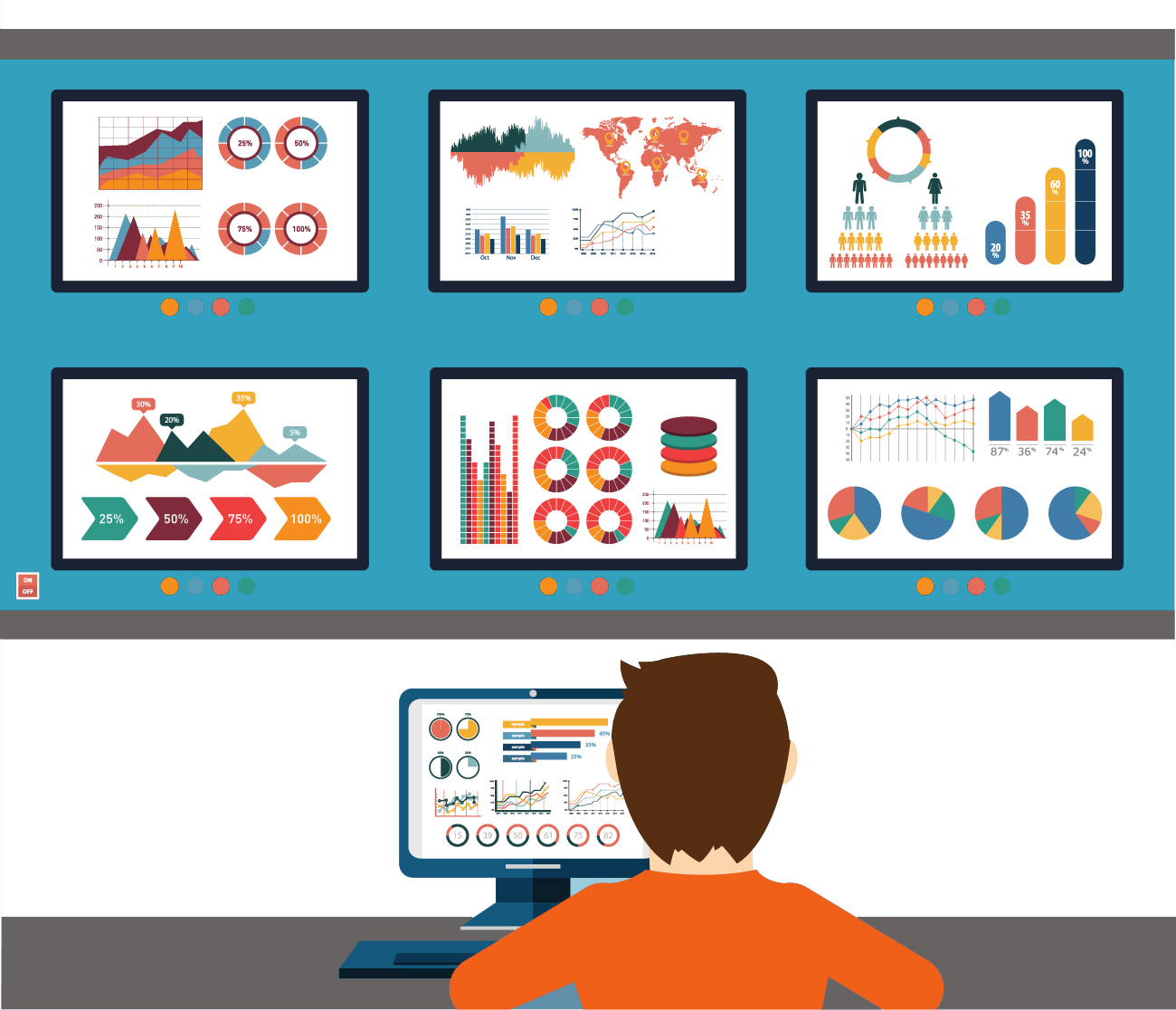
Data dashboards enhance emergency situational awareness
Situational awareness in emergency management
In emergency management, much is made of the importance of situational awareness.
Understandably so. Up-to-the-minute knowledge of objects, events, people,  system states, interactions, environmental conditions, and other situation-specific factors is critical to mobilizing a rapid, efficient, and effective emergency response.
system states, interactions, environmental conditions, and other situation-specific factors is critical to mobilizing a rapid, efficient, and effective emergency response.
Situational awareness, however, is not an aim in and of itself. Knowledge and understanding of the current disaster situation, as described in the U.S. Army Field Manual, is meant to promote the timely, relevant, and accurate assessment of an operation – to facilitate real-time decision making.
Situational awareness, as such, is the means. Decision support is the end. And key to decision support is the collecting, analysis, and understanding of historical inefficiencies, through the creation of data models. Where responses include multiple agencies and entities, as they so often do in emergency management, those data models will cluster together diverse, event-specific data sources –lots of them.
Challenges of Situational awareness in emergency management
That’s not the only challenge to effective decision support in emergency management.The aim of decision support is to enable agencies to detect and report incidents automatically, as well as dynamically adapt resource allocation and dispatch approaches, even if the environment in which the emergencies occur changes.
To do so, agencies must develop incident forecasting models that:
1. can generalize across large geographic areas,
2. have high spatial-temporal resolution, and
3. handle high data sparsity.
It’s not that easy, though. Further complicated  by the fact that agencies must respond to daily incidents and large-scale disasters, alike; and the decision support capabilities needed to deal with these two types of events vary greatly.
by the fact that agencies must respond to daily incidents and large-scale disasters, alike; and the decision support capabilities needed to deal with these two types of events vary greatly.
Disasters and security attacks, for instance, are likely to hinder operations by knocking out communications. In such incidents, agencies will require forecasts over fine spatial and temporal resolutions, argue experts; yet, learning incident prediction models at high resolutions in this context is extremely difficult due to data sparsity
And as mentioned above, achieving situational awareness itself requires information from lots of different data sources – sources which are often noisy.
Why does it matter? Well, integrating noisy data sources into real-time incident detection models is complex. Rendered even more complex because the learning procedures that go into these models must also be adaptive.
With those challenges affecting the delivery of effective decision support in emergency management, agencies often inquire what can be done?
As this guide will argue, Data Driven Dashboard capabilities within emergency and disaster management software can help.
can generalize across large geographic areas, have high spatial-temporal resolution, and handle high data sparsity.
| Challenges to Situational awareness in emergency response | ||||||
| Challenge | Capability management challenge | |||||
| Coordination | Emergency response management (ERM) requires coordination between multiple agencies and decision makers, each with their own objectives. Each decision maker often has access to only incomplete information, and coordination must happen quickly while a situation is unfolding. | |||||
| Data collection | It’s difficult to collect, integrate, and pre-process the eclectic data that forms the foundation for emergency response systems. Much of the data has high volume and velocity and is from diverse sources. This large set of data must then be narrowed down to a set of useful features. | |||||
| Critical Event forecasting | Incident occurrence is difficult to model due to incidents’ inherent randomness and high sparsity. We have also shown that incident models are sensitive to spatial-temporal resolution, which makes high-fidelity models challenging to learn. | |||||
| Critical Event detection | Fast incident detection is critical for timely response, but traditional reporting methods have time delays. Crowdsourced data-streams (e.g., Waze) provide an opportunity for early identification, but are noisy and uncertain. | |||||
| Dynamic Environments | The environments in which ERM systems operate change over both long- and short-time scales. ERM systems must adapt to this non-stationarity. | |||||
| Communications | Many emergency incidents cause failures in communication networks. ERM systems must be robust to communication loss to maintain service in such situations. | |||||
The rise of Data Driven Dashboards
Dashboard systems that provide real-time, relevant information on the current state of the organization to executive-level decision makers aren’t new. They first emerged in the 1970s, taking off in the 1980s, thanks to advances in computer displays and graphical user interfaces.
Subsequent innovation in the 1990s and early 2000 served to lower development costs, widening accessibility of Data Driven Dashboards to lower-level managers. This wider accessibility proved key to the take-off of Data Driven

Dashboard s in the business world. These dashboards, as we know them today, are meant to provide “key, relevant information,” allowing for the summary of volumes of data in meaningful measures. They do so by means of intuitive visualizations, militating against information overload.
Why then don’t many emergency management systems come equipped with them?
Well, the acceptance of Data Driven Dashboards in emergency and disaster management has happened more gradually – often begrudgingly.
But done right, Data Driven Dashboards in emergency management provide the same basic functionality, in that these operational and executive dashboards – still, retaining the single display format, to visualize data and KPIs with charts and gauges and enable monitoring of assets and resources in real-time – allow emergency managers to better comprehend data from complex, data feeds.
What’s more, the visualized presentation of information in emergency services, just like in the business world, enables emergency managers to grasp insights out of noisy data sources, helping them to make more informed decisions, take precise actions, and create more comprehensive strategies during a crisis.
Best practice in Data Driven Dashboards for decision support in emergency management
What’s needed from dashboards, however, differs from there.
Emergency managers rely on operational and executive dashboards to support a different type of mission than their for-profit  business counterparts. Tasks that Data Driven Dashboards must support in emergency management include:
business counterparts. Tasks that Data Driven Dashboards must support in emergency management include:
Deliver situational awareness in a complex, multi-organizational environment
Alert users to emerging issues and problems in rapidly changing crisis environment. Develop valid estimates of the changing status of the operational environment in complex highly interdependent systems. Deliver timely information to improve decision making.
Furthermore, effective coordination between multiple organizations, as involved in the emergency response, relies on the development of a common operating picture. That means implementing dashboards will require more than just accessing information from multiple sources – the multi-agency context further adds legal, cultural, and organizational challenges than in the business context.
Unsurprisingly, the resultant process often involves multiple protocols and security restrictions. That drastically raises the technical ante and sharply increases implementation costs. Which is why emergency management agency leadership often shies away.
Incumbent emergency management systems often present stark usability issues, complain their practitioners and administrators. These usability challenges limit day-to-day applicability of Data Driven Dashboards – users simply don’t want to use the systems and will go to lengths to create effortful workarounds.
The result: legacy systems, particularly ERPs and CRMs, stand less of a chance of being used properly during a disaster, due to lack of familiarity and proficiency.
Data Driven Dashboard capabilities to consider
All is not lost, though. Emergency and disaster management vendors on the market, such as Zapoj CEM Platform, have done the requisite market research to understand when and how emergency users need information briefly.
As a result, Zapoj have developed Data Driven Dashboard offerings for executive, operational, and day-to-day practices. The platforms enable the following:
Follow your own processes or use best practices: With graphical drag-and-drop designers, you can create or modify dashboards, data models, forms, charts, templates, and workflows, without a single line of code. Platform capabilities also expand as you need them, even during an incident.
Coordination among teams: The platforms let you work in a digital “room” of your EOC, as well. There, dashboard and collaboration spaces are provided for emergency teams, such as command, operations, planning, and logistics.
Even better:it’s easy to set up new dashboards with just the tools your team needs.
Maintain situational awareness: Did we mention situational awareness? An annex of decision support but important. And the platforms, designed around google maps, work to help teams create a common operating picture via field personnel updates, GIS feeds, data import, email, and social media.
Work from anywhere: The platforms also communicate with staff and volunteers anywhere they use a web browser or iOS and Android apps. Every dashboard on desktop automatically resizes for mobile devices, making all the same tools available on the go.
Finally, effective decision support has never been more important to emergency  management, as the number and intensity of critical events increases. Too many organizations, though, lack the capabilities to enable effective decision making.
management, as the number and intensity of critical events increases. Too many organizations, though, lack the capabilities to enable effective decision making.
That must change. Luckily, innovative vendors, like Zapoj CEM Platform, have been working overtime to learn how emergency managers prefer relevant data visualized and deliver on those user preferences.
While legacy vendors take a high-handed, take-it-or-leave- it approach, innovators have developed a data driven dashboard for executive, operational, and day-to-day practices. These dashboards bring best practices to the fore (or let organizations use their own), while enabling better coordination among teams and agencies.
The result: teams and agencies can more easily maintain situational awareness from the comfort of an EOC (digital, physical, or a combination of the two), which is key to making the best decisions when it matters most.
Are youprepared to handle critical events? Signup for free
If you intersted to follow our blogs : Subscribe
